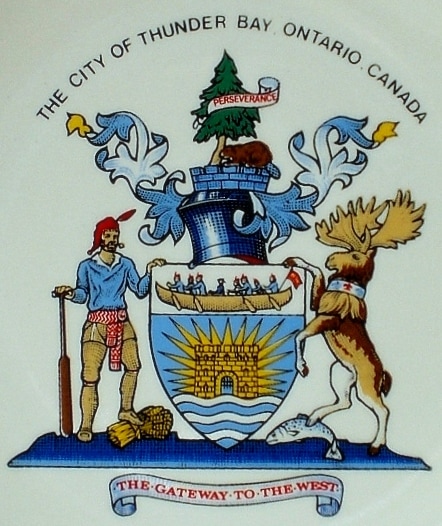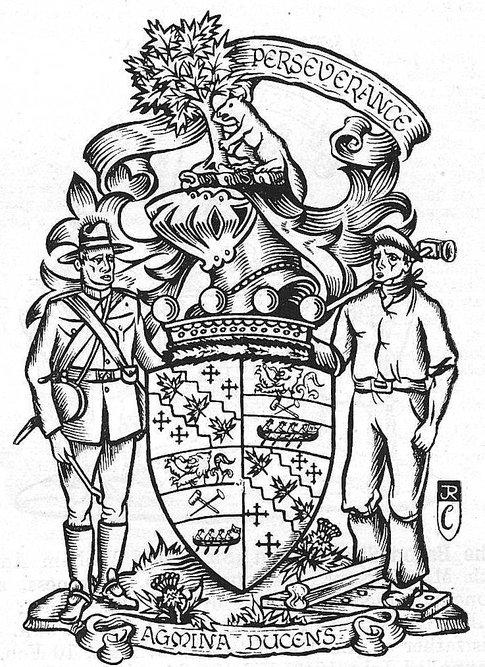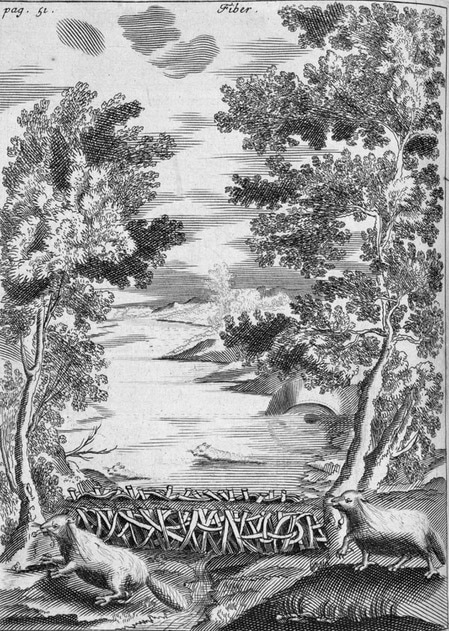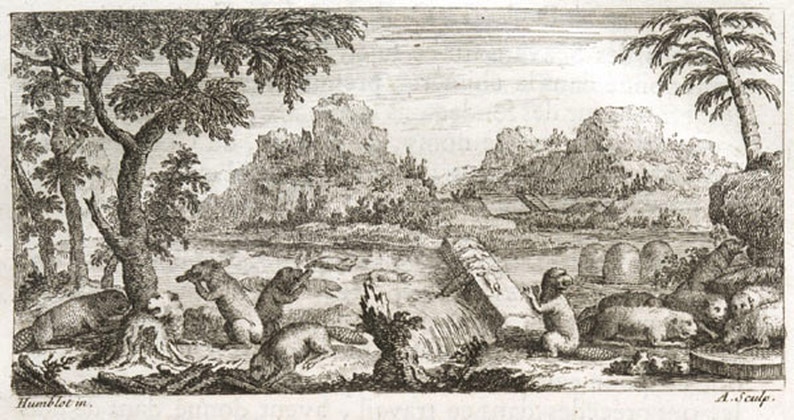Appendix I
The Beaver Cutting Down a Maple
Beavers do cut down maples and today there are photographs of this on the internet. In earlier printed imagery, although a beaver cutting down a tree is fairly frequent, the instances where that tree is a maple are quite rare. Because both the beaver and the maple are emblems of Canada, they are often paired together such a beaver with a leaved maple twig in the mouth, a beaver on a maple log, a beaver on a maple leaf or with maple branches or wreaths, but when the image is a beaver felling a tree, that tree is rarely identifiable as a maple.
Emblems
The Upper Canada Preserved medal, struck by the Loyal and Patriotic Society of Upper Canada during the War of 1812, shows a beaver gnawing at the stub of a broken tree with a leaved branch, but the leaves do not appear to be those of a maple. The arms attributed to the North West Company and those granted to William and Simon McGillivray by the Kings of Arms of England on 6 June 1823 both show a beaver gnawing at a tree as the crest. Early illustrations of these arms clearly feature a coniferous tree although the patent granting the arms merely states “A Beaver gnawing at the root of a Tree all proper” (natural colours). [1] The Beaver Club pendant inscribed “Beaver Club instituted Montreal 1785.” also features a beaver biting into a tree, but its leaves are not of a maple. The seal of the North West Company displays a similar image, but again the tree is not distinct enough to be identified as a maple. Third class tokens of the Montreal and Lachine Railroad Company (1847-1850) feature a beaver chewing on a branch beside the stub of a large tree with two leaved branches. Again positive identification of the tree by its leaves is uncertain and the tree appears to be broken, not felled by the beaver. The heraldic description of the crest granted to Thunder Bay, Ontario, by the Kings of Arms of England in 1970, blazons the crest: “a Beaver gnawing at the root of a Pine Tree proper” (fig. 1). Associating beavers with conifers is unusual since they rarely cut down such trees. In the coat of arms granted to Donald Alexander Smith, 1st Baron Strathcona, c. 1900, the crest is described as “a beaver eating into a maple tree” (fig. 2). It is the only Canadian emblem I have found where the tree being chewed into is identified as a maple. (Many of the coats of arms mentioned here are illustrated in chapter VI of my work A Guide to Heraldry, see http://heraldicscienceheraldique.com/chapter-vi-an-auxiliary-science.html.
The Upper Canada Preserved medal, struck by the Loyal and Patriotic Society of Upper Canada during the War of 1812, shows a beaver gnawing at the stub of a broken tree with a leaved branch, but the leaves do not appear to be those of a maple. The arms attributed to the North West Company and those granted to William and Simon McGillivray by the Kings of Arms of England on 6 June 1823 both show a beaver gnawing at a tree as the crest. Early illustrations of these arms clearly feature a coniferous tree although the patent granting the arms merely states “A Beaver gnawing at the root of a Tree all proper” (natural colours). [1] The Beaver Club pendant inscribed “Beaver Club instituted Montreal 1785.” also features a beaver biting into a tree, but its leaves are not of a maple. The seal of the North West Company displays a similar image, but again the tree is not distinct enough to be identified as a maple. Third class tokens of the Montreal and Lachine Railroad Company (1847-1850) feature a beaver chewing on a branch beside the stub of a large tree with two leaved branches. Again positive identification of the tree by its leaves is uncertain and the tree appears to be broken, not felled by the beaver. The heraldic description of the crest granted to Thunder Bay, Ontario, by the Kings of Arms of England in 1970, blazons the crest: “a Beaver gnawing at the root of a Pine Tree proper” (fig. 1). Associating beavers with conifers is unusual since they rarely cut down such trees. In the coat of arms granted to Donald Alexander Smith, 1st Baron Strathcona, c. 1900, the crest is described as “a beaver eating into a maple tree” (fig. 2). It is the only Canadian emblem I have found where the tree being chewed into is identified as a maple. (Many of the coats of arms mentioned here are illustrated in chapter VI of my work A Guide to Heraldry, see http://heraldicscienceheraldique.com/chapter-vi-an-auxiliary-science.html.
Fig. 1. Coat of arms of the City of Thunder Bay, Ontario, granted by the Kings of Arms of England in 1970. The heraldic description of the crest is “a Beaver gnawing at the root of a Pine Tree proper,” although the tree is consistently depicted like a fir tree. On a plate by Canadian Art China; Collingwood Ontario, Canada. Vachon Collection, Canadian Museum of History.
Fig. 2. The arms of the Baron Strathcona and Mount Royal originally granted to Donald Alexander Smith, 1st Baron Strathcona, c. 1900. The crest is described as “a beaver eating into a maple tree.” The tree is minuscule or the beaver gigantic. A beaver attacks a tree a bit above the ground like a true lumberman, not near its crown. From Burke’s Peerage, 1949, p. 1922.
Other Beaver Imagery
As for emblems, beavers cutting down maple trees are rare in printed form such as on engravings, posters and advertisements. One of the early engravings appears in a 1664 work by François Du Creux, a Jesuit priest who wrote a history of Canada based on the Jesuit Relations and conversations he had with missionaries having worked in New France. The trees being gnawed at by beavers are not distinct enough to venture any identification (fig. 3). The second engraving is from the 1744 work of Pierre-François-Xavier de Charlevoix, a Jesuit priest and teacher in New France. Again one can only guess at what the tree might be (fig. 4).
As for emblems, beavers cutting down maple trees are rare in printed form such as on engravings, posters and advertisements. One of the early engravings appears in a 1664 work by François Du Creux, a Jesuit priest who wrote a history of Canada based on the Jesuit Relations and conversations he had with missionaries having worked in New France. The trees being gnawed at by beavers are not distinct enough to venture any identification (fig. 3). The second engraving is from the 1744 work of Pierre-François-Xavier de Charlevoix, a Jesuit priest and teacher in New France. Again one can only guess at what the tree might be (fig. 4).
Fig. 3. Beavers felling unidentified trees. Fiber at the top of the page is Latin for beaver. From Father François Du Creux, Historiae canadensis, sev Novae-Franciae libri decem, ad annum vsque Christi MDCLVI [History of Canada or New France in Ten Books until the Year of Christ 1656] (Paris: Sébastien Cramoisy and Sébastien Mabre-Cramoisy, 1664), p. 51. Library and Archives Canada.
Fig. 4. Beavers cutting down an unidentified tree. Pierre-François-Xavier de Charlevoix, Histoire et description generale de la Nouvelle France [...], vol. 3 (Paris: Didot, 1744), p. 1. Library and Archives Canada.
In more recent printed imagery, the beaver is associated with maple branches, logs and leaves in a symbolic way, but when the beaver gnaws at a tree, it is rarely recognizable as a maple. I have noticed the same constant in Donna and Nigel Hutchins’ The Maple Leaf Forever (2006) which contains many illustrations of beavers cutting down trees. For instance, page 50 shows the cover of a maple butter tin (La cie nationale de beurre d’érable) featuring in centre a beaver felling a tree. On the border is a frieze of traditional beavers chewing on a maple branch separated by large red maple leaves which is a way of bringing together the two emblems of Canada. The tree itself only shows a short part of the trunk and is not identifiable, all the more so that an oak leaf appears on each side of the scene. It stands to reason that the beaver should not be destroying the tree which is the source of maple butter. One reason why the beaver is not necessarily cutting down a maple is that, as stated above, it is not its favourite tree. Sir John William Dawson (see above) found it annoying that a beaver should cut down the national tree. In other words, it seems more satisfying that the two emblems have a cozy relationship rather than an adversarial one.
Note
[1] I have a typed copy of the letters patent from the Hudson’s Bay Company Archives.
[1] I have a typed copy of the letters patent from the Hudson’s Bay Company Archives.



